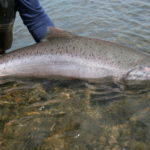 On February 23rd 2023 at the AGM it was proposed from the floor and with a majority vote that the Association would make all waters of the Association Catch and Release for Salmon fishing from 1st October again this year.
On February 23rd 2023 at the AGM it was proposed from the floor and with a majority vote that the Association would make all waters of the Association Catch and Release for Salmon fishing from 1st October again this year.
It was decided that from this date that all salmon caught should be returned carefully to the river using full catch and release practises. Remember that bait fishing is not allowed from the 1st October as it is harder to safely release salmon using this method. Any member caught with a salmon carcass in their possession from the 1st October will be deemed in breach of this regulation and will be suspended from the Club. Dead or alive the salmon must be returned to the river. Loughs Agency rules will apply as per reverse of the permit ie.
Angling is permitted only with a single barbless hook with a gape of 12mm or less. From the 1st October the use of earthworms, as bait, is prohibited.
Thankfully as the years have progressed we have now many more members practising catch and release so this should not really cause too much of an upset to most. I would like to thank all these members for being proactive in protecting salmon for the years ahead. We are complying with the majority of members feelings who attended the AGM in Feb 2023. Don’t forget if you kill a salmon then you are denying this fish the possibility of spawning which in turn will only help decline salmon numbers for future generations. Please see catch and release information below. Any member found with a salmon after this date will face suspension from the AssociationHopefully this will help.
..
Fishing Tackle
The angling method used can have a significant bearing on the survival rate of released salmon Anglers intent on releasing fish, or anglers fishing waters where a catch and release rule is in force. should carefully consider the angling method used. Salmon caught by fly fishing using single barbless hooks, have a greater chance of survival than fish caught on barbed hooks, hooks or lures with double or treble hooks.
Barbless hooks do less damage, are easier to remove and reduce handling time which can be in important factor influencing survival. Barbed hooks can have the barb pinched with a pliers to allow salmon to be released more easily. Where it is not possible to use barbless hooks, hooks used should be single. The fishing tackle used should be strong enough to enable the fish to be brought in quickly. taking account of the prevailing conditions and the possible size of the fish that might be caught.
Playing the Fish
Playing a fish in the following way will help its chances of survival:
- Avoid exhausting the fish
- In the river, move the salmon out of the fast current into quieter water
- Once the fish is subdued bring it quickly to the bank
Landing the Fish
Research has shown that exposing a salmon to air for even a short period, for example to take a photograph, can significantly reduce its chances of survival.
- Keep the salmon in the water at all times.
- Use a large diameter landing net with soft knotless mesh
- Avoid beaching the fish
- No gaffs or tailers
- Always handle the salmon with wet hands
Removing the Hook
- Wet your hands and keep the fish in the water. Handling of the fish should be minimized
- When necessary the fish should be supported from beneath and the hook gently removed either by hand or by means of long-nosed forceps
- If a hook is deeply embedded and cannot be removed, the leader should be cut close to the hook, as fish released with the hook attached will generally survive
- Take extra care with fresh fish, as they are more prone to scale loss, injury and subsequent fungal infection
- Care must be taken not to squeeze the fish or hold it by the gills
Releasing and Reviving the Fish
- After removing the hook or cutting the leader, the fish should be supported in the water facing into the current and given sufficient time to recover
- Hold the fish gently until it is capable of swimming away strongly
- Avoid weighing the fish
- The weight can be estimated from its length using a conversion chart
- A tape measure or a wading stick can be used to take the approximate length while keeping the fish in the water
Survival Chances of Released Salmon
- Research has shown that the survival rate of salmon caught and released can he close to 100% when the above guidelines are followed
- Survival rate is greater at water temperatures below 20 C.
- Very good survival to spawning of released rod-caught spring Salmon, which have subsequently spent up to nine months in the river before spawning, has been recorded in Scotland
- Spawning success and viability of eggs are unaffected in salmon caught and released in late autumn

1 comment
Absolutely correct, its good that exact advice is given in the article on how to treat a captured fish.